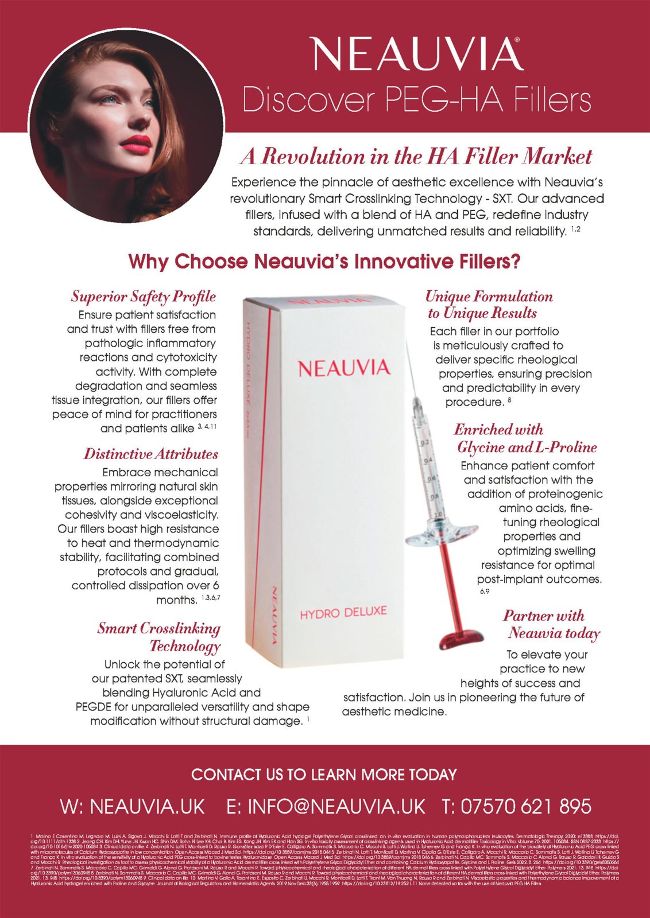PRP
The Princess and the PRP
Regenerative expert, nurse Claudia McGloin answers all your burning questions
CLAUDIA MCGLOIN
Claudia McGloin is a registered nurse and holds dual registration in both the UK and Ireland. With over 26 years’ nursing experience, McGloin is the clinical director and nurse practitioner at The New You Clinic in Sligo. She is one of Ireland’s leading platelet-rich plasma experts and has performed thousands of PRP treatments. She has shared her expertise on the international stage and in various publications.
“IS INJECTING PLATELET-RICH PLASMA DURING A TREATMENT PAINFUL?”
Platelet-rich plasma (PRP) treatments are not painful but it will depend on the treatment you are administering. Patients may experience mild discomfort or stinging sensations during the injection process, but this is typically mild and temporary. Some patients will have a lower pain tolerance than others and will of course find this treatment a bit more painful and uncomfortable. You can address this in several ways. If you numb patients’ skin prior to injecting, this will help hugely. Also, consider your method of delivery; you can administer PRP via mesogun, cannula, needle, skin needling devices or pen. In my experience, it is kinder to apply anaesthesia on the patient’s skin prior to injecting, but I often have patients who tell me to just inject without. These patients have a good pain threshold and can tolerate the procedure without anaesthetic, but this is where your consultation will question how well your patients tolerate both pain and needles. Remember, there is not a once-size-fits-all solution. A good tip is to have a stress ball in clinic, that will help take their mind off the injections. When I’m doing a treatment, I’m always chatting to them which also helps take their minds off what’s going on.

“HOW LONG SHOULD THE PRP TREATMENT TAKE?”
How long is a piece of string? The time taken for a PRP treatment will vary depending on the treatment you are doing, the area and the complexity of the treatment. Other factors, such as how confident and experienced you are with PRP, will also affect this. The process of taking the patients’ blood and spinning and preparing the PRP will take up half the time, while the rest of the time will be taken injecting. I usually leave myself between 60-90 minutes for a treatment. You do not want to rush any aspect of a PRP treatment, including the prep. It will also depend on whether you are numbing up the face first or not. Typically, doing a hair treatment will take a bit longer than the face.
For me, if I’m doing an orthopaedic joint treatment then it is much quicker. That said, take your time doing the treatment and do not rush. You want the best outcome and the best experience for your patient. Don’t feel rushed to have completed a treatment within a certain timeframe. The more experience you have, the faster you will become at performing a treatment. I do see practitioners saying they can complete a treatment within 30 minutes. No! Take your time!
“I HAVE A CLIENT WHO WANTS SKIN NEEDLING BEFORE PRP INJECTIONS. SHE DOESN’T WANT TO COMBINE THE TREATMENTS.”
There is absolutely no issue with having these procedures done either together or separately. You need to explain to the patient what your protocol is for skin needling and that you maybe applying a layer of PRP onto their skin prior to the needling but that you will inject the rest of PRP using a specific protocol for the areas requiring treatment. Advise them that they may experience more downtime and administer the approriate aftercare.
“CAN YOU POINT ME TOWARD ANY PAPERS OR ARTICLES EXPLAINING THE DIFFERENCES/BENEFITS OF IPRF OVER PRP?”
There are lots of clinical papers available on PRP. Have a look on Wiley and PubMed. If you do a Google search, you will see a list of clinical papers. Some of these you can read online and some you may have to pay for. There is literally so much information available online. If there is anything specific that you are looking for, drop me an email at the address below.
“DOES PRP WORK ON BREAST?”
PRP won’t increase the breast cup size or give the breast a lift. There was a paper a few years ago that addressed the breast and PRP, but a dermal filler was also injected into the breast tissue. If PRP is injected into the breast, depending on the volumes, the tissues can appear fuller. Safety of injecting breast tissue with PRP is an area that requires further study. I am currently investigating and reviewing a paper on this and will write about this in a future article. PRP can be used for superficial lines and wrinkles and can improve the skin texture of the breast. It is often used for correction and wound healing following surgical procedures.
If you have questions regarding any aspect of regenerative medicine – PRP, PPP, PRF, polynucleotides, exosomes – or questions relating to treatments, please get in touch either by contacting Aesthetic Medicine or emailing claudia@thenewyouclinic.ie.